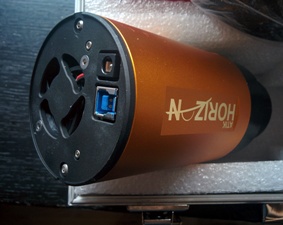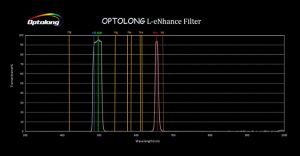This is a first light report of a few nights out with my new Atik Horizon Camera (OSC) compared with an Atik 383L+ and Infinity. To sum it up, the camera performed well even under terrible light conditions. Most significant, the Atik Horizon allows Live Stacking with the Infinity Software, one method to do Electronically Assisted Astronomy (EAA) i.e. real-time (or nearly real-time) viewing of astronomical objects (usually deep sky) with aid of electronic devices.
Although I use my Atik 383+ mono camera for narrow band (false colour) images, spectroscopy and photometry, when I crave for colour and fast deep sky images like nebulae and star clusters my choice was often the Atik Infinity. The reason is, because EAA with colour cameras and Live Stacking is perfect suited for what I choose to call “Lazy Casual Astrophotography“, even though for certain targets a mono camera is certainly better.
Lazy means to me the 80/20 rule, with 20% of the effort gets good enough 80% astrophotography within seconds or minutes and Casual to get them at my city life attic or garage roof, where I often “see nothing” with visual observation because of light pollution and bad seeing. Naturally the first Atik CMOS Camera with a cooled 16MP 4/3″ 12 bits sensor (OSC) was a great option to upgrade from my Atik Infinity and even Canon 60Da DSLR. For an extensive article about Live Stacking with the Infinity and its Infinity Imaging Software please see here. Click here for a short Presentation of Electronically Assisted Astronomy (EAA).
First light Setup
- A memory buffer improves data transfer reliability from 4656 x 3520 pixels Panasonic chip (3.8×3.8 microns pixel size) and a fast USB3 computer interface speeds it up. The (new) robust USB 3.0 B-Type model Atik Horizon connector is now easier to plugin. The Horizon has standard M42x0.75 female thread interface and back focus of 13 mm just like of the Infinity (Atik 383L+ has 17mm).
All of this, the “fast” cooling down time and the compatibility to the Infinity accessories and optical constraints (and last but not least the Live Stacking Software) has been good news to me and is highly appreciated in the field.
- Imaging telescope: Ludes TMB80/600mm
- Imaging camera: Atik Horizon Camera (OSC),
- Mount: Skywatcher HEQ-5 Pro SynScan
- Guiding telescope: TS Deluxe Guider/Finder60 mm/240 mm focal ratio 1:4
- Guiding camera: Starlight Xpress Lodestar X2 Autoguider und CCD camera
- Filter: 2″ Baader 2″ Skyglow Neodymium, Ha, OIII, SII,UHC-S, on ATIK 2″ motorized filter wheel – USB connection alternatively RGB,
- Focal reducer: Long Perng 2″ 0.6x Reducer and Corrector for APO Refractor
- Software (at Mini-PC): Atik Capture, Atik Infinity (Version 5.0.1.6) from August 8th 2019, Open PHD Guiding, Card du Ciel
First light Conditions Atik Horizon Camera (OSC).
Light conditions were terrible with city light pollution worsened by high humidity and some high clouds. The Perng corrector gave reasonable illumination and correction for Atik sensor (supports up to 30 mm) and my slow refractor with a focal ratio f7. However I believe my reducer (tricky choice to begin with) was not 100% correct parallel and maybe was 0.5 mm off distance wise. The whole Setup brought my 4A+ power supply to its knees, so that my secondary old HEQ-5 Pro SynScan mount already on the limit as well, had to work even harder. It showed its annoyance by blinking at every guiding correction.
A six Ampere power supply is at minimum required for this setup and will probably reach its limit with my Skywatcher AZ EQ6GT, which I use in the field or outside.
Comparison of used Imaging Cameras
As mentioned all three cameras are used with an almost identical HW and SW Setup. Of course Live-Stacking Infinity can only be used for the Infinity and Horizon Atik cameras.
| 383L+ | Infinity | Horizon | |
| Image Sensor | KAF-8300 | ICX825 | 4/3 CMOS |
| Resolution | 3362×2504 | 1392×1040 | 4644×3506 |
| Pixel size | 5,4×5,4 | 6,45×6,45 | 3.8×3.8 |
| ADC | 16 bit | 16 bit | 12 bit |
| Readout noise | 7e | 5e | ~1e- at x30 gain |
| Cooling Delta | -40 | Passive | -40 |
| Regulated cooler | Yes | No | Yes |
| Max exposure | Unlimited | Unlimited | Unlimited |
| Min exposure | 0,2s | 0,001s | 18μs |
| PC Interface | USB2 | USB2 | USB2/3 |
| Power | 12VDC,2A | 12VDC,1A | 12VDC,2A |
| Backfocus dist. | 17±0.5 mm | 13±0.5 mm | 13±0.5 mm |
| Thread | M42x0,75 | M42x0,75 | M42x0,75 |
| Weight | 700g | 340g | 525g |
| Mine | Mono | OSC | OSC |
Imaging Results Atik Horizon Camera (OSC)
First Light One Shot Colour (OSC) imaging with UHC-S Filter
Below there is the first try with a Horizon using UHC-S broadband filter. I took those images from my office a few days ago, under mediocre conditions plus my “White Zone” background. Also shown here are DSS Live stacking results after they had enhanced with PixInsight. I was positively surprised of the results. The M110 M31/M32 image has been done without reducer.
M110 M31/M32
| Center (RA, Dec): | (10.296, 40.994) |
| Center (RA, hms): | 00h 41m 10.947s |
| Center (Dec, dms): | +40° 59′ 39.884″ |
| Size: | 1.69 x 1.27 deg |
| Radius: | 1.056 deg |
| Pixel scale: | 5.93 arcsec/pixel |
| Orientation: | Up is 73.1 degrees E of N |
NGC 7000/ IC 5070
| Center (RA, Dec): | (314.262, 44.078) |
| Center (RA, hms): | 20h 57m 02.915s |
| Center (Dec, dms): | +44° 04′ 42.423″ |
| Size: | 2.84 x 2.15 deg |
| Radius: | 1.782 deg |
| Pixel scale: | 10 arcsec/pixel |
| Orientation: | Up is 40.1 degrees E of N |
________________________________________
Atik Horizon Camera (OSC) with Narrowband Filter
Below there is the first try with a Horizon using UHC-S as RGB and Ha & OII narrowband filters. I took those images from my office some days later. Also shown here are DSS Live stacking results after they had enhanced with PixInsight.
IC 1805
| Center (RA, Dec): | (38.144, 61.552) |
| Center (RA, hms): | 02h 32m 34.512s |
| Center (Dec, dms): | +61° 33′ 07.663″ |
| Size: | 2.57 x 2.1 deg |
| Radius: | 1.661 deg |
| Pixel scale: | 9.04 arcsec/pixel |
| Orientation: | Up is 192 degrees E of N |
________________________________________
Narrowband imaging carries with it several advantages over LRGB or One Shot Colour imaging. Firstly, narrowband filters select out a very distinct part of the spectrum, which corresponds to a particular emission line and cut out a lot of light pollution (not necessarily white LED broad spectrum light pollution, however). Secondly, stars appear significantly less bloated and nebulosity appears richly detailed. These narrowband images were be used to enhance One Shot Colour images, and to produce Horizon composite images in their own right on base of Narrow Band Colour images. This is wasting pixels, so I am contemplating to buy a Dual Narrowband Filter later on.
Atik 314L+ with Narrowband Filters
In this paragraph I compare the Horizon with a monchrome Atik 314L+ Mono and narrowband filters. In order to do son, I took more images from my office a day later. Those narrowband images were be used to produce images in their own right based on mono colour composites without RGB.
IC1805
| Center (RA, Dec): | (38.022, 61.525) |
| Center (RA, hms): | 02h 32m 05.356s |
| Center (Dec, dms): | +61° 31′ 30.792″ |
| Size: | 2.81 x 2.1 deg |
| Radius: | 1.752 deg |
| Pixel scale: | 9.87 arcsec/pixel |
| Orientation: | Up is 314 degrees E of N |
As most of the visible Universe is Hydrogen, the emission line for Hydrogen-Alpha is particularly prominent. Therefore Narrowband imaging tend to capture images through multiple narrowband filters. I have Hydrogen-Alpha, Hydrogen-Beta, Sulphur-II and Oxygen-III. Here I used only Hydrogen-Alpha and Oxygen-III to produce colour images of the Bicolour Palette with PixInsight combining.
The first way of combining Hydrogen-Alpha and Oxygen-III simulated the look of an LRGB (or OSC) image. Firstly, the stacked and enhanced linear Hydrogen-Alpha image (called HA) was assigned to the Red channel and the prepared Oxygen-III image (called OIII) was assigned to both, the Green and the Blue channels, as such R/K: HA, G: OIII, B: OIII.
After clicking Apply on Pixel Math created a new colour image just on base of narrow band,
In absence of a third narrowband image I performed synthetic green combination. This is dobe again very easily in PixInsight by simply multiplying the Hydrogen-Alpha as such: R/K: HA, G: (HA*OIII)*1.5, B: OIII.
Next I really got creative. In a blended channels mode I experimented as such: R/K: HA, G: (0.4*HA)+(0.6*OIII), B: OIII.
________________________________________
The detailed description one can learn from a PixInsight Processing Tutorial: Narrowband Bicolour Palette Combinations.
First Light One Shot Colour (OSC) imaging with
In the future I plan also doing false color mapping with my one shot color camera and a multi band-pass filter like the high-end STC for instance. While one will not be able to fully isolate each emission line using this combination, the different types of gas emission lines come out with higher contrast even under severe light pollution conditions.
The use of my MONO/SW camera and narrow-band nebula filters costs valuable exposure time which I often don´t have. A dual band pass filter is specially developed for color cameras lets through important areas in which nebulae glow, such as H-alpha, H-beta and oxygen (O-III). The rest is blocked. The filter seems to be a real alternative to narrow-band nebula photography with my Atik 383L+.
Therefore I just ordered an Optolong L-eNhance filter based on a terrific experience report (see link below) for my Atik Horizon Camera (OSC). The idea behind Narrow Dual Band with color imaging is that one does all the blending with Color Calibration in PixInsight from one stacked image (even simple Photoshop would do).
In PI one could theoretically extract pseudo RGB (i.e. R=Halfa and G+B=OIII= and follow the normal combination procedures with PixelMath, although I don’t see any advantage in this.
As soon I get my hands on the Optolong L-eNhance I will continue this chapter with Atik Horizon and Narrow-band Dual-Band filter results processed by PI.
Links
-
New PixInsight Processing Tutorial: Narrowband Bicolour Palette
-
Optolong L-eNhance Narrow-band Dual-Band pass filter for DSLR or one-shot-color astronomy camera
- Observing with Astro Video Cameras (Rod Mollise in the February 2013 issue of Sky & Telescope; republished on August 24, 2015): www.skyandtelescope.com/astronomy-resources/observing-with-astrovideo-cameras/
- Informationen zu EAA (Electronically Augmented Astronomy), EAO (Electronically Augmented Observation/Observing) Gerd Waloszek# www.waloszek.de/astro_eaa_d.php


